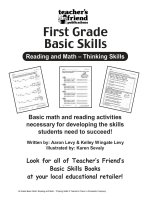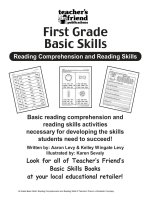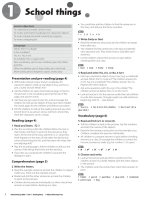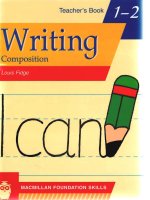2fidge louis primary foundation skills reading
Bạn đang xem bản rút gọn của tài liệu. Xem và tải ngay bản đầy đủ của tài liệu tại đây (6.09 MB, 48 trang )
Comprehension
Louis Fidge
•
Comprehension
Louis Fidge
MACMILLAN FOUNDATION SKILLS
Contents
Page
Skills, scope and seq.uence
2
Teacher's notes - introduction to the series
4
Teaching features of the books
5
Unit 1
I can do the same as you!
6
Unit 2
I like school
8
Unit 3
The space monster
10
Unit 4
Alphabetical people
12
Unit 5
Follow the leader
14
Unit 6
Bedtime
16
Unit 7
How to make a glass xylophone
18
Unit 8
Shadows
20
Unit 9
Our family comes from round the world
22
Unit 10
The lion and the mouse
24
Unit 11
A dinosaur came to school
26
Unit 12
Mrs Wilson's week
28
Unit 13
My eyes can see
30
Unit 14
Our class trip
32
Unit 15
The gingerbread boy
34
Unit 16
A tree
36
Unit 17
Mark's mask
38
Unit 18
Jack and the beanstalk
40
Unit 19
Gorillas
42
Unit 20
Here is the ostrich
44
High freq.uency word list
46
uence
kil ls, scope and s
-
Unit 1
Text Type
Text Level
Sentence Level
Word Level
-
Unit 2
Text Type
Text Level
Sentence Level
Word Level
I I can do the
-
sam-; as you!
I Autobiograp hical tex t w it h fa miliar setti ng
Sentenc e completion (literal com prehen sion)
Focus on verb s
cvc words with short med ial a
-
-
-
-
-
I like school
I Autob iograph ical text with f amiliar set ting
True or fal se statements (lit eral comprehension)
Focus on verbs
Short words ending with -n q
-
-
Unit 3
Text Type
Text Level
Sentence Level
Word Level
The space monster
Fantasy adventure
Sentence completion (multiple choice)
Focus on noun s
Consonant digraph ch
Unit 4
Text Type
Text Level
Sentence Level
Word Level
Alphabetical people
Alphabetically-organised texts
Sentence completion (literal comprehe nsion)
Indefi nite article
Alphab etical knowledge and order
Unit 5
Text Type
Text Level
Sentence Level
Word Level
Follow the leader
Story with familiar setting/ inst ruct ions
Sentence com pletion (lite ral comprehe nsion)
Punctuation - capital letters and f ull stops
cvc words with short medial 0
Unit 6
Text Type
Text Level
Sentence Level
Word Level
Bedtime
Story with familiar setting/fantasy
Questions (literal comprehension)
Word order - sentence st ruct ure
cvc w ords wi t h sho rt medial e
Unit 7
Text Type
Text Level
Sentence Level
Word Level
How to make a glass xylophone
Instructions
Features of inst ructions/ sequence
Punctuation - capital letters and question marks
Short words endin g with - ck
Unit 8
Text Type
Text Level
Sentence Level
Word Level
Shadows
Information text
Literal questions
Focus on adjectives - drawn responses
Consonant digraph sh
Unit 9
Text Type
Text Level
Sentence Level
Word Level
Our family comes from round the world
Choral poem, with patterned language
Questions (literal and appreciative)
Focus on adjectives
cvc word s with short medial j
Unit 10
Text Type
Text Level
Sentence Level
Word Level
The lion and the mouse
Traditional story
Characterisation
Focus on verbs (animal noises)
cvc words with short medial a and u
2
-
-
-
-
Unit 11
Text Type
Text Level
Sentence Level
Word Level
A dinosaur came to school
Fantasy story with familiar setting
Matching sentence beginnings and endings
Focus on nouns
a-e words (magic e)
Unit 12
Text Type
Text Level
Sentence Level
Word Level
Mrs Wilson 's week
Story with patterned language
Sentence completion (literal comprehension)
Capitalising proper nouns
Months of the year
Unit 13
Text Type
Text Level
Sentence Level
Word Level
My eyes can see
Poem with patterned language/familiar setting
Correcting 'silly' sentences
Regular plurals + s
Short words ending in -II
Unit 14
Text Type
Text Level
Sentence Level
Word Level
Our class trip
Recount
True/false statements
Adjectives/opposites
Short words ending in -ck
Unit 15
Text Type
Text Level
Sentence Level
Word Level
The gingerbread boy
Traditional story
Sentence completion (literal comprehension)
Matching sentence beginnings and endings
s + consonant blends at beginning of words
Unit 16
Text Type
Text Level
Sentence Level
Word Level
A tree
Information text
Sentence completion (multiple choice)
Commas in lists
Vowel digraphs ee and 00
Unit 17
Text Type
Text Level
Sentence Level
Word Level
Mark's'mask
Explanatory text in familiar setting
Sequencing
Ordinal number words - drawn responses
o-e words (magic e)
Unit 18
Text Type
Text Level
Sentence Level
Word Level
Jack and the beanstalk
Traditional story
Sentence completion (literal comprehension)
Categorising nouns (odd one out)
High frequency words
Unit 19
Text Type
Text Level
Sentence Level
Word Level
Gorillas
Information text
Literal questions
Sentence structure - spacing words
Short words ending in -nd
Unit 20
Text Type
Text Level
Sentence Level
Word Level
Here is the ostrich
Action rhyme
Literal questions
Subject/verb agreement -is or are
i-e words (magic e)
3
Teacher's notes - introduction to
the serie
The texts
Each book in the series introduces pupils to a wide range of culturally appropriate text
types, including fiction, poetry and non-fiction. The books are carefully graded according
to readability and are incremental in difficulty. The books provide a valuable complement
to any other resources or series currently being used. The fact that each unit is structured
in the same way makes the books accessible and easy to use.
The related activities
The related activities support the development of essential reading skills at Text Level,
encouraging pupils to read at different levels using literal, inferential and evaluative
comprehension skills. The stimulus passages are also used to help pupils develop skills at
Sentence Level (grammar and punctuation) and Word Level (spelling and vocabulary).
The skills, scope and sequence chart
The 'skills, scope and sequence chart' (on pages 2-3) provides an immediate overview of
text types included and skills being developed at Text, Sentence and Word Level. This
chart is very helpful for planning purposes.
Using the books
To gain maximum benefit from the books, it is suggested that they are used
systematically, working through each unit one at a time, in the given order. However, the
books may also be used flexibly, selecting units as desired to complement other work
being done in class.
Tackling the texts
The stimulus texts may be tackled in a variety of ways. They could be used for shared
reading. This could take the form of the teacher reading the whole text to the class or
inviting different pup ils to contribute as appropriate. Certain texts e.g. poems, provide
an ideal opportunity for whole class participation. Alternatively the pupils could be asked
to read the text silently or read it aloud in pairs or in groups. Whatever approach is
used, to make the most of each text it should be discussed to ensure pupils have a good
grasp of the literal meaning of the text and any vocabulary they may not have met
before. Key vocabulary words are printed in bold type, and the Teacher's Book indicates
how these might be dealt with. The related Text Level activities may initially be done as
a class verbally to help pupils reflect on the texts.
Tackling the related activities
The related activities at Text, Sentence and Word Level may be used systematically or
selectively as desired . It is suggested that prior to working any activity there is some
discussion with the pupils to ensure they understand what is required of them.
4
Teaching features of the books
Units of work
There are 20 double-page units of work. Each unit is structured in the same way
i.e. a stimulus text, followed by three different levels of activities (Text, Sentence and
Word Level).
Unit number and title
Te xt Level activities
(a range of differentiated
comprehension tasks)
I can do the same
as you!
Sentence Level activities
(grammar or
punctuation tasks)
Complele Ihe missing word
1 I can g_ _ fast.
2
3 I can h_
_ .
4
5 I can d_ _.
6
What th ings are easy to do ?
What th ings are hard to do ?
I can c
a ball.
I can p_ _.
I can i_ _.
SfllnHa Llyn
Choose the correct verb to fill each gap.
1
2
3
4
5
6
Key vocabulary
in bold type
A fish can swun . (swim / hop)
A bird can _ _. (sing / moo)
A frag can _
_
. (slide/ hop)
A snoke can _
_
(hop / slide)
A lion can _ _ . (roar I sing)
A cow can _ _
. (moo/ roar)
0
'NOm Ll Vft
Make the wo rds.
1
3
c s on e ccn
p + on
_
5 f + an ~
7 c +at = _ _
9 p +al = _ _
11 b + 01 =
Text for reading and discussion
2
4
m + an ::l
6
y
t
+ on :r.
+ an =
m + at =
8
10
r +al = _
12
5 +01 = _ _
_
Word Level activities
(spelling and vocabulary tasks)
High frequency word list
This list includes a number of regularly occurring words at this level. The list may be used
for teaching purposes, ensuring that the words are included in writing and spelling
activities and in reading tasks. The list also may be used as a checklist to see how many
words the pupils can recognise on sight and to identify those which require further
teaching.
5
I can do the same
as you!
What th ings are easy to do?
What th ings are hard to do?
I co n go fast.
I can catch a ball.
I can hide.
I can paint.
I can drink.
I can jump!
6
Complete the missing word.
1 I can g
fast.
2
3 I can h
4
5 I can d
6
I can c- - a ball.
I can p
_
I can j
_
Choose the correct verb to fi II each gap.
1 A fish can swtrn . (swim / hop)
2 A bird can
. (sing / moo)
3 A frog can
. (slide / hop)
4 A snake can
. (hop / slide)
5 A lion can
. (roar / sing)
6 A cow can
. (moo/roar)
Make the words.
1 c + an = .ca.n.
3 P + an =
5, f + an =
7
9
11
c + at =
P + at =
b + at =
7
2
4
6
m + an =
r + an =
v + an =
8
10
12
m + at =
r + at =
s + at =
I like school
What do you like doing best at school?
I like reading.
I like writing.
I like painting.
I like drawing.
I like cutting.
I like playing.
I like sticking.
We like school!
8
EXT [EVEL
Which of these things can you see on page 8?
1 I like sticking.
2 . I like writing.
3 I like sleeping.
4 I like shouting.
5 I like painting.
6 I like drawing.
SE ir ENCE t EV EL
Write the correct form of the verb in each
2 I like
1 I like readtnq . (read)
. (cook)
4 I like
3 I like
. (sing)
6 I like
5 I like
sentence.
. (jump)
. (help)
. (sleep)
RD t EV EL
sing bang
song king
long
gang
ring
hang
gong
Write all the tng words.
2
1 sLn.g
3
Write all the ang words.
4
5
6
Write all the ong words.
7
8
9
9
The space monster
If you met a space monster, what would you do?
A spaceship landed in my garden.
d
A funny green monster with ~~
yellow spots came out.
I showed him an apple.
I showed him a chair.
I showed him a pencil.
I showed him a car.
When I shO-~d him a spider
he ran away!
10
Choose the correct word for each sentence.
1 A spaceship landed in my
_
(garden / bedroom)
2 The space monster was
with
_ _ _ _ spots. (yellow / green)
3 I showed him an
. (apple / orange)
4 I showed him a
. (car / cart)
5 When I showed him a
he ran away.
(cat/ spider)
SE 'fENCE LEVEL
Choose the correct noun for each sentence.
1 You eat an a.pple. (apple / chair)
2 You sit on a
. (book / chair)
3 You draw with a
(car / pencil)
4 You drive a
. (chair / car)
5 You sleep 'in a
. (pencil/bed)
6 You read a
. (book / bed)
Copy these words . Fill in ch in each word.
b _ _ Ip
C _ _ op
a c h. at
d - ick
e - oose
f - In
h - eese
n -
9. - est
pln _ _
k lun -
J mu -
1 1
Alphabetical people
Can you say the alphabet?
A is for astrona ut.
An astronaut goes up
into space in a spaceship.
C is for clown.
A clown makes us laugh.
E is for editor.
An editor checks books
for mistakes . .
D is for dentist.
A dentist looks after our
teeth ..
F is for farmer.
A farmer grows crops or
looks after animals on a
farm.
12
Finish each sentence correctly.
1
2
3
4
5
6
An astrona ut - - - - - - - - - - - - A dentist - - - - - - - - - - - - - - A farmer - - - - - - - - - - - - - - A clown
A builder
- - - - - - - - - - -- - - An editor
SE irENCE LEVEL
Write a or an in front of each noun.
1 a. ball
3
cat
5 _ elephant
7
insect
9
man
2
4
6
8
10
ant
door
fish
house
umbrella
1 Write the letter that comes next in the alphabet:
a c d
b t
c h
e p
d k
.
g o_ h m f w -
i y- J q
2 Write the letter that comes before:
c
h
k
c
a
b
t
d
m i -y
f
w
h
g - o
13
e _p
j
- q
Follow the leader
Have you ever played the game 'Simon Says'?
Do you know how to play it?
Simon says point to your nose.
Simon says touch your toes.
Simon says wave your hand.
Simon says dance to the band.
Simon says hop to the shop.
We all say it's time to stop!
14
Write the
1 Simon
2 Simon
3 Simon
4 Simon
5 Simon
6 Simon
missing word in each sentence.
says wave your
_
says touch your
_
says dance to the
_
says point to your
_
says hop to the
_
says it's time to
_
SE ifEN CE LEVEL
Begin each sentence with a capital letter.
Finish each sentence with a full stop.
1 the boy waves his hand Th.e bo~ wa.ves
2 the girl climbs the tree
3 a frog hops
4 you smell with your nose
. 5
his h.a.n.d.
the lady likes to dance
_
Fill in the missing 0 in these words.
Write the words you make.
1 h op
4
7
10
sh _ P
f_g
I
t
h.op
2 P_ P
5
8
11
_
_
d_ 9
j_g
n t
15
3 st _ P
6 I_g
9 h
t
12 g _t
Bedtime
Why do we need to sleep?
It was time for bed.
The mouse got into bed. The cat got into bed.
The lion got into bed.
The crocodile got into bed.
".
The hippo got into bed.
The elephant got into bed.
"
"":
The bed broke and they all fell out!
16
1
2
3
4
5
6
Who got into bed after the mouse?
Who got into bed after the cat?
Who got into bed after the lion?
Who got into bed after the crocodile?
Who got into bed after the hippo?
What happened when they were all in bed?
The words in these sentences are in the wrong orde r.
Write each sentence correctly.
1
2
3
4
5
6
The bed got into mouse.
It was bed for time.
The broke bed.
The shines sun.
Dogs bark can.
Fish swim water in.
Th.e mouse got trite bed.
bed peg hen net red get
wet beg fed
1
2
3
4
Write
Write
Write
Write
the ed words.
the eg words.
the en words.
the et words.
leg ten
bed.
17
pen
How to make a
glass xylophone
Can you playa musical instrument?
What you need
four glass bottles
some water
some paints
a stick
What you do
1
Put some water into
the glass bottles.
2
Ma ke the level of the
water different in
each bottle.
3
Make the water in
each bottle a different
colour. Put some paint
into each bottle.
4
Tap the glass bottles
with the stick. Each
bottle will make a
different note.
18
1
2
3
4
5
What
What
What
What
What
do you need to make a glass xylophone?
do you do first?
is the second thing you do?
is the third thing you do?
is the last thing you do?
Write these questions correctly. Put in the
capital letters and question marks.
1 how old are you How old a.re ~ou?
2 when is your birthday
_
3 where do you live
4 who is your teacher
_
5 what number comes before five
- - - - - - -
1
2
Find the words that rhyme and draw lines.
stick
sack
pack
kick
neck
suck
rock
peck
duck
lock
Choose the best word to fill each gap.
a I put a
on my foot. (sack / sock)
b A chicken can
. (peck / pack)
c A
can quack. (dock/ duck)
. (neck, rock)
d A giraffe has a long
19
Shadows
What is your shadow? When can you see it?
Is it always the same?
My shadow can be long.
My shadow can be short.
When the sun comes up my I
shadow is long.
,, / _1
/
\
In the middle of the day my
shadow is short.
When the sun goes down my
shadow is long again.
When the moon comes
out I ca 11 ma ke shadow
shapes with my hands.
20
/
--
, I/
/'
...............
\
Answer these questions.
1 Do you have a shadow?
2 Can your shadow be long?
3 Can your shadow be short?
4 What is your shadow like when the sun comes up?
5 What is your shadow like in the middle of the
day?
6 Do you have a shadow when the moon comes
out?
SE ifENCE t EVEl
In your book, draw:
1 a long pencil
3 a red car
5 a black cat
1
2
4
6
a round ball
a happy girl
a little mouse
Copy these words. Underline the sh in each word .
ship fish wish shop crash
sheep rush shoe shell brush
2 Write the sh words in two sets:
words with sh
at the beginning
ship
~
-
words with sh
at the end
I
fish
~
21
Our family comes from
round the world
This poem tells us how the world is like a family.
Our family comes
From round the world:
Our hair is straight,
Our hair is curled,
Our eyes are brown,
Our eyes are blue,
Our skins are different
Colours, too.
Hurray hurrah hurrah hurree
We're one big, happy family!
We laugh and cry,
We work and play,
We help each other
Every day.
The world's a lovely
Place to be
Because we are
A fornily.
Hurray hurrah hurrah hurree
We're one big, happy family!
22
1
2
3
4
5
6
Who is in your family at home?
Is your hair straight or curly?
What colour are your eyes?
Do you like to laugh or cry?
What games do you like to play?
How can you help your teacher at school?
SE
Choose the best adjective for each sentence.
1 The su n is h.ot . (hot / cold)
2 The grass is
. (red / green)
3 The sea is
. (black / blue)
4 A banana is
. (long / tall)
5 Water is
. (wet / big)
6 A ruler is
. (straight/ curly)
Copy these words. Underline the odd word out in
each set.
1 big
dig wig
2 pin tin win him
3 fig lip tip Zip
4 sit hit lid fit
5 fix pit .mix SIX
6 bib lid hid did
lJlI2
23









